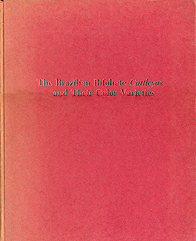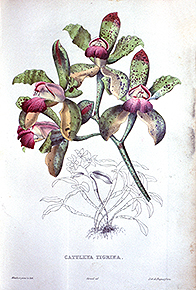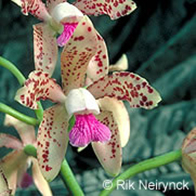T H E B R A Z I L I A N
B I F O L I A T E C A T T L E Y A S.
and their Color Varieties
door/by J. A. Fowlie, B.S., M.D.
en met aquarellen van de hand van Mrs. Rosalie Roth/and with aquarelles by Mrs. Rosalie Roth.
132 pp., 19 kaarten, 5 pentekening, 37 zwart-wit foto, 24 aquarellen, 73 kleurenfoto’s.
1997, Day Printing Corp., Pomona, Californië, USA.
132 pp., 19 maps, 5 pen drawing, 37 black and white photographs, 24 aquarelles, 73 color photos.
1997 Day Printing Corp., Pomona, California, USA.

 Cattleya tigrina A. Richard in
Cattleya tigrina A. Richard in
Portefeuille des horticulteurs

Cattleya tigrina A. Richard
Om een standaardwerk op een ernstige manier te schrijven is er een massa voorbereidend werk nodig. De auteur deed dit door in het wild verzamelde planten -hij geeft een nauwkeurige vermelding van de plaats van herkomst- door een aantal medewerkers te laten kweken tot ze bloeiden om dan de bloemen te laten fotograferen of aquarelleren. De verschillende soorten werden gecatalogeerd en beschreven. Alle gegevens werden tot een synthetisch geheel verwerkt.
Het resultaat is een grondige bespreking van de tweebladige Braziliaanse Cattleya-soorten op een voorbeeldige wijze geïllustreerd.
Fowlie brengt de Braziliaanse tweebladige Cattleya-soorten onder in de secties Laelioides, Gymnochila, Cryptochila, Granulosae, Guttatae en Intermediae. In het totaal worden 19 soorten uitgebreid besproken en afgebeeld.
Twee Braziliaanse tweebladige Cattleya-soorten zal men in dit werk echter niet vinden. Cattleya tenuis en Cattleya kerrii werden immer pas na de publicatie van dit boek ontdekt en beschreven.
Per soort geeft Fowlie een uitgebreide beschrijving van de naam:
- waar van toepassing de ‘nomen obscurum’ of ‘nomen nudum’
- de synoniemen
- een literatuurlijst
- waar van toepassing de verkeerde namen
Hij schetst de geschiedenis van elke soort.
Onder de rubriek ‘discussie’ wordt dieper op de soort, haar ontdekking, enzovoort ingegaan.
Dan komt een uitgebreide beschrijving per soort aan bod, de bloeitijd wordt vermeld en de vindplaatsen, ook de evolutie van die vindplaatsen komt aan bod. Er is ook een sleutel voor determinatie gepubliceerd en enige notities over het kweken van deze planten.
Het boek sluit af met dankzeggingen en een index.
Een kanttekening? Fowlie laat ook in dit boek, juist als in zijn monografie ‘The Genus Lycaste’, een steek vallen. Hij publiceert Cattleya tigrina A. Richard als Cattleya leopoldii Verschaffelt ex Lemaire. Zijn motivatie om Cattleya tigrina A. Richard een ‘nomen obscurum’ te noemen is als volgt: “It should be mentioned that this plant seems to have been first described by A. Richard in ‘Portefeuille des horticulteurs’ Vol. II p. 166 with plate for 1848 as Cattleya tigrina. Although considerable effort was necessary to locate this very rare periodical, reference to the plate and description leaves no doubt in my mind about what he was describing.”
Vertaald klinkt dat als volgt: “Het moet vermeld worden dat deze plant voor het eerst beschreven zou zijn geweest door A. Richard in Vol. II p. 166 met een afbeelding, 1848, als Cattleya tigrina. Ondanks noemenswaardige inspanningen die nodig waren om die zeer zeldzame uitgave te traceren, laat de referentie naar afbeelding en beschrijving volgens mij er geen twijfel bestaan over wat hij beschreven heeft.”
Fowlie heeft die eerste beschrijving dus niet gezien.
Waar hij voor zijn Lycaste-monografie er niet toe kwam om de resten van het herbarium van Ruiz & Pavon in Madrid te gaan bestuderen, slaagde hij er niet in om 'Portefeuille des horticulteurs' te raadplegen. Om te bewijzen dat dit wel mogelijk is, publiceer ik hierbij een kopie van de tekst en de prent uit ‘Portefeuille des horticulteurs’. Laat het ons erbij houden dat de druk van de dead-line zo groot was dat er geen tijd meer restte om hier en daar de enkele zaken wat diepgaander te bestuderen: jammer.
The Brazilian Bifoliate Cattleyas is een boek dat het lezen én het bekijken waard is, ook voor hen die geen Engels verstaan of kunnen lezen.
To write a standard work in a serious way, there is a mass of preparatory work needed. The author letted grow wild collected plants -he gives an accurate indication of the place of origin- by a number of cooperators until they bloomed, to have them photographed or aquarelled. The different species were cataloged and described. All data were synthetically processed.
The result is a thorough discussion of the two-leaved Brazilian Cattleya species illustrated in an exemplary manner.
Fowlie brings the two-leaved Brazilian Cattleya species in sections Laelioides, Gymnochila, Crypto Chila, Granulosae, Guttatae and Intermediae. A total of 19 species are discussed and illustrated.
Two two-leaved Brazilian Cattleya species are not discussed in this work: Cattleya tenuis and Cattleya kerrii were ever discovered and described after the publication of this book.
By species Fowlie gives a detailed description of the name:
- Where applicable, the ‘nomen obscurum’ or ‘nomen nudum’
- Synonyms
- A bibliography
- Where appropriate, the wrong names
He traces the history of each species.
Under the heading ‘discussion’ he gives a deeper look on the species, its discovery, etc...
Then comes a detailed description of each species, the flowering time is indicated, and their distribution, the evolution of the sites where the species grow is discussed. There is also a key for identification and some notes about growing these plants.
The book closes with acknowledgements and an index.
A comment? Fowlie, just as in his monograph ‘The Genus Lycaste’, publishes at least one doubtful note. He publishes Cattleya tigrina A. Richard as Cattleya Leopoldii Verschaffelt ex Lemaire. His motivation to mention Cattleya tigrina A. Richard a ‘nomen obscurum’ is as follows: “It should be mentioned that this plant seems to have been first described by A. Richard in ‘Portefeuille des horticulteurs’ Vol. II p. 166 with plate for 1848 as Cattleya tigrina. Although considerable effort was necessary to locate this very rare periodical, reference to the plate and description leaves no doubt in my mind about what he was describing.”
So, Fowlie which did not see A. Richards’ first description.
Where he for his Lycaste monograph did study the remains of the herbarium of Ruiz & Pavon in Madrid, he failed to consult 'Portfolio of horticulteurs. To prove that this is possible, I publish herewith a copy of the text and the picture from Portefeuille des horticulteurs’. Let us accept that the pressure of the dead-line was so great that no time was left to study some things into the depth: a pitty.
The Brazilian Bifoliate Cattleyas is worth reading and watching, even for those who do not understand nor read English.